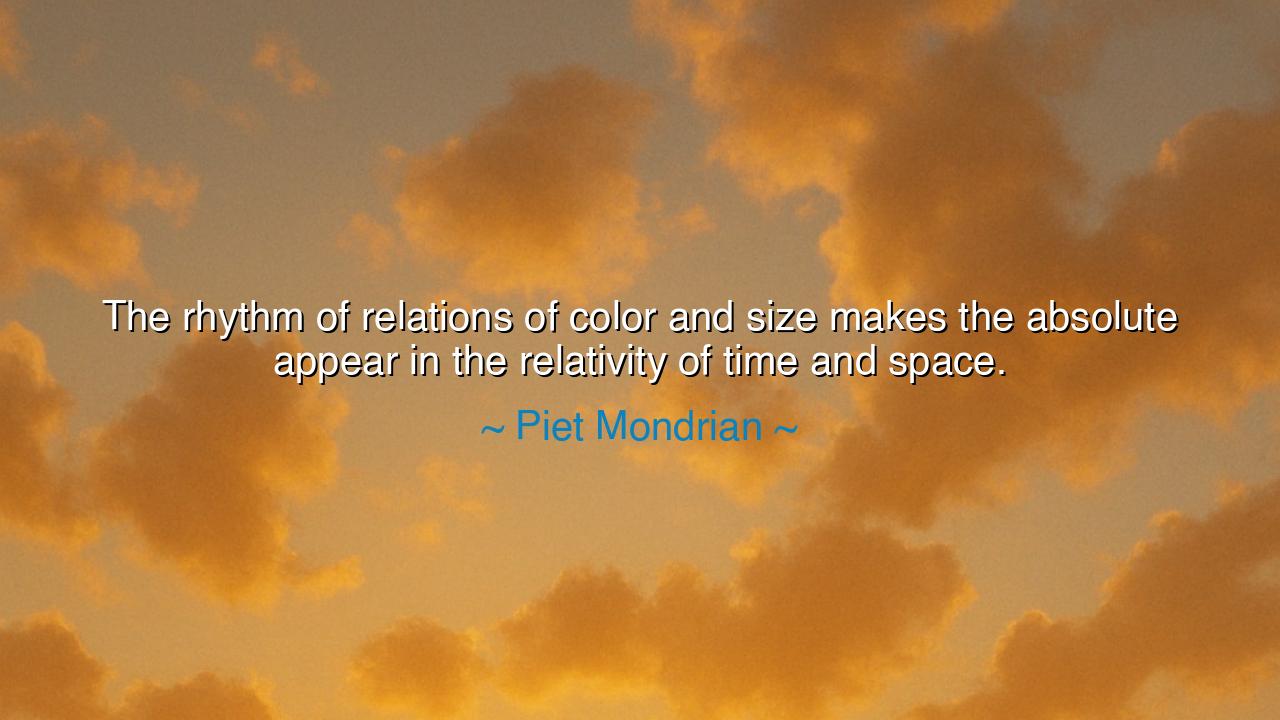
The rhythm of relations of color and size makes the absolute
The rhythm of relations of color and size makes the absolute appear in the relativity of time and space.






Piet Mondrian, the painter-philosopher of pure form, once spoke with words as mysterious as his art: “The rhythm of relations of color and size makes the absolute appear in the relativity of time and space.” His saying is not a riddle for the idle mind, but a vision for the soul that seeks meaning beyond the veil of appearances. In his art, Mondrian reduced the world to the elemental—lines, planes, primary colors—yet in this reduction, he sought not simplicity but the eternal. His words teach us that through harmony of form, through balance of proportion, the absolute—that which is eternal and divine—may be glimpsed even within the fleeting relativity of the physical world.
The ancients would have nodded at this wisdom, though it comes clothed in modern paint and canvas. For the philosophers of Greece also sought to see the eternal forms behind the shifting illusions of time. Plato spoke of the Forms, the eternal truths of beauty, justice, and harmony, which cast mere shadows into our world. Mondrian, in his way, painted these shadows with color and shape, declaring that the rhythm of relations reveals the eternal to the human eye. Where others saw only rectangles and primary hues, he saw a doorway into eternity.
His words remind us that harmony is not found in grandeur alone, but in the balance of opposites—the large with the small, the red with the blue, the still with the moving. The rhythm of relations is the secret heartbeat of existence, the same principle that makes music divine, poetry timeless, and architecture sacred. A cathedral’s beauty is not in its stones alone, but in the way those stones relate to one another in size, rhythm, and symmetry. Likewise, Mondrian’s canvases speak of the universe itself: that time and space are not chaos, but dance, and in the dance, one can glimpse the absolute.
History gives us an echo in the builders of the Parthenon. They did not raise their columns at random but measured them with divine proportion, so that their rhythm reflected the eternal harmony of the cosmos. Centuries later, when Mondrian painted his grids, he was seeking the same truth: that proportion and relation reveal more than geometry—they reveal eternity shining through temporality. The Parthenon and Mondrian’s canvases are kin, though separated by millennia.
This teaching is not confined to art alone. It extends into life itself. Our relationships, our actions, our words—each is part of the rhythm of relations that makes harmony or discord in the world. When our lives are out of balance, when size and color are misaligned, we feel only chaos. But when we cultivate proportion—between work and rest, between giving and receiving, between silence and speech—then we begin to see the eternal meaning of our lives. Like Mondrian’s canvas, our existence becomes an image of the absolute shining in the relative.
The lesson is clear: seek harmony in all things. Do not chase chaos or excess, but learn the art of proportion. Let your life be like Mondrian’s painting—bold in its colors, strong in its lines, yet balanced in its form. In such a life, time and space will no longer feel like prisons, but like vessels carrying a glimpse of eternity.
Therefore, carry Mondrian’s words as a torch in your heart: the absolute may seem distant, but it is hidden within the rhythm of daily life, in the balance of your actions, in the relations you cultivate, in the harmony you create. Look to the world with the eye of the artist, and you will see that even in the shifting tide of time, eternity is waiting, revealed in balance, revealed in rhythm, revealed in the simple yet profound dance of color and size.






AAdministratorAdministrator
Welcome, honored guests. Please leave a comment, we will respond soon